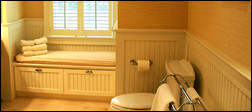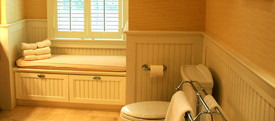Of the many types of wainscot and paneling options, beadboard stands out for its unique appearance and classic cottage house feel. Beadboard is far from a one-size-fits-all wainscot, however. There are numerous variations within the
 Beadboard wainscoting gives this bathroom a refined look. Photo courtesy of Wainscoting Long Island. |
family that bring a wide selection of individual panel widths and bead depths and spacing, as well as configuration and height options. Consumers also have a choice in material and finish, from pre-primed ready-to-paint products to authentic woods like cherry or maple.
Installing beadboard wainscot can be a fun weekend project. DIY homeowners can outfit a room in several hours with little more than a table saw and a nail gun. Popular “pre-fabricated” wainscoting packages are even easier to install, sliding and locking into place like puzzle pieces.
Beadboard History
The three main styles of wainscot—raised panel, flat panel and beadboard—are all derived from the works of Western European woodworkers. Popular in 18th and 19th century Europe, beadboard was commonly found in less formal settings and homes, like cottages or retreats. “They were originally created to protect the lower portion of walls from water damage,” says Harold German of Wainscoting Long Island, an online resource matching consumers with wainscoting manufacturers and distributors. “The flooring structures of homes in those times where not as sophisticated as they are today, thus a decorative solution to the problem surfaced. Today, wainscoting is used as a decorative wall embellishment with nominal practical function.”
The Many Faces of Beadboard
“Beadboard wainscoting” denotes a style of wainscoting that has individual tongue and groove planks lined up side by side and framed by a chair railing (also called a top rail) above and a baseboard (also called a base, or bottom,
 Installed beadboard from New England Classic |
rail) below. In many of today’s beadboard products, the tongue and groove appearance is achieved on long sections or “sheets”—often sold in eight-foot lengths—that are easier to cut and install. The “bead” in beadboard refers to the design that is cut vertically into the panel. The many width and style options of both the individual panels and the beads result in a wide variety of beadboard choices. Other beadboard wainscot products feature the horizontal stiles common in raised and flat panel wainscot, separating the beaded panels at regular intervals.
Consumers will face material decisions, as well. In addition to wood, there are MDF (medium density fiberboard), plaster and vinyl/plastic options. MDF is a popular option for settings subject to humidity and moisture, like coastal homes or bathrooms, because the MDF will resist the warping and cracking that can afflict some species of wood, such as pine. The MDF products are also less expensive when compared to higher-end hardwoods like cherry, maple and oak. “MDF beadboard costs about half to a third as much as hardwood,” says Richard Duke, customer service manager for New England Classic, manufacturers of wainscoting systems. MDF products can come with a wood veneer that achieves the look of finished or unfinished hardwood and can be pre-primed and ready to paint any number of colors suitable for the room. New England Classic can also do custom colors if a customer sends a color sample to them, according to Duke.
Homeowners will need to determine the desired finished height of the installed finished beadboard. The 32-inch and 36-inch heights are the standards, and
 Installed beadboard from New England Classic |
many beadboard system manufacturers offer 40- and 44-inch finished heights, too. Depending on how a homeowner purchases the materials, the finished height can be adjusted by purchasing a taller or shorter bottom rail. “Consumers should be aware that cost can jump pretty significantly when going from the more standard 40-inch height to, say, 60 inches,” says Herb Mena of Elite Trimworks, Inc., wainscoting and molding manufacturers and distributors based out of Toronto, Canada.
Made to Order
Purchasing a customized beadboard wainscoting system has become a popular choice for the homeowner looking to refine a room’s look. Companies like New England Classic allow homeowners to purchase customized and sized wainscoting kits by submitting room measurements and desired configurations. The patented interlocking system featured in the company’s kits make installation much easier for the homeowner. “The kits come with a frame pack—which includes the base rail, top rail, caps and shoe moldings—and the 8-foot long panel sets,” says Duke. Assembling the product, he continues, is like “fitting together a jigsaw puzzle.” The free estimate and CAD drawing provided by the company also make budget choices and visualization of the finished install easier. If electing to go the pre-measured, ready-to-assemble route, homeowners should know the room dimensions and desired finished height; individual wall measurements, locations and heights of windows and doors; and the location and heights of other features such as wall outlets.
Depending on the company, the kits can come completely ready to install or requiring some basic sizing and cutting. “Our standard kits are eight-feet-long,” says Mena, “so customers will need a table saw to fit and install.” A jigsaw may be required to cut out holes for outlets, too.
Stretching the Buck
Typically, the hardwood beadboard products sit on the costlier end of the wainscot spectrum. MDF and other engineered options are less expensive. Most wainscot kits or products are sold by the square foot—linear foot costs can be simply calculated by multiplying square foot costs by the height of the finished product. For example, the pre-primed, ready-to-paint beadboard kit sold by New England Classic costs $6.60 per square foot. For the three-foot high finished option, this price comes out to $20 per linear foot. That same company’s factory finished cherry option, by contrast, costs $19.10 per square foot or $57.30 per linear foot for the same height. Professional installation will increase the cost, and a homeowner needs to get an estimate based on a price per square or linear foot installed.
Installation Considerations
Installing beadboard wainscoting can be a rewarding challenge for the weekend warrior, depending on the products used. Ready-to-assemble kits like those
 |
||||
|
||||
offered by New England Classic will go up with far less fuss and will require minimal tools. “If [the homeowner] purchased pre-measured, pre-assembled wainscot kits, all they need is some adhesive, nails and a tape measure, and installation is a cinch,” says German. The key to installing a New England Classic system, says Duke, is getting the bottom rail right. “As long as you have the bottom rail level, everything just fits into place,” he says. Reading the installation manual before installing is vital to a successful job, he adds.
For homeowners choosing to design, cut and install their own wainscoting, a little more patience, know-how and equipment will be required. For tools, a table saw, nail gun and miter saw are essential for cutting exact lengths of panel sheets and rails and to make the 45-degree cuts necessary on the corners of the room. As mentioned, a jigsaw will be needed to cut out the holes for outlets.
Credit: Renovate Your World




























